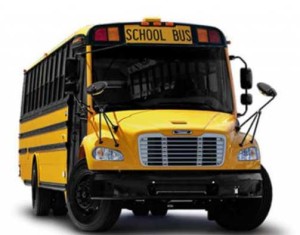Unionville board of ed. awaits cost analysis to see which is less expensive over the long haul
By Mike McGann, Editor, UnionvilleTimes.com

Unionville schools officials will be working up numbers to determine whether buying new school buses, such as the Thomas/Frieghtlininer pictured above will be more cost effective than buying used 2009 models.
EAST MARLBOROUGH — More school buses are coming, but the only question now is whether buying new models or slightly used models will be the best long-term value for the Unionville-Chadds Ford School District.
The Board of Education is expected to approve bids Monday night during its regular session at Hillendale Elementary School to add six buses to the district’s aging school bus fleet. But, the question looms: is it less expensive in the long run to buy new buses or 2009 models?
The question of how to manage bus purchases was the primary topic of last Monday’s board Finance Committee meeting.
The district is currently budgeted to spend $340,000, which will cover the cost of six used buses, coupled with the trade in of six of the bus fleet’s oldest models. Changing the order to six new buses would up the amount to $444,000, an added expense of more than $100,000. Another option would be splitting the order between new and used vehicles, which would cost about $390,000.
Although three less buses are needed for the 2011-12 school year thanks to reworking of bus routes, district officials plan to keep those three extra buses as spares, allowing the district to keep in-house some transportation of sports teams that been going to outside contractors.
On the surface, buying the older buses would seem to be the more economic move, but, the new buses have some benefits that could end up saving more money in the long run. First, the new buses come with a two-year warranty, which would cut maintenance costs, and the new buses get better fuel milage — about two MPG better — roughly 12 MPG versus 10 MPG for the older buses.
There is also some depreciation advantage to buying the new buses versus the older models, seven years for the older buses, versus 10 years for the new models. The two-year-old buses have about 75,000 miles on them — out of an expected life of 200,000 to 300,000 miles.
But — and district Director of Business and Operations Robert Cochran was expected to work up a fiscal analysis before Monday’s night meeting working out the cost factors over the life of the buses — are those benefits enough to make up for the price difference: about $60,000 per bus for the used models and $75,800 for the new buses?
Gail Wolfel, the district’s Supervisor of Transportation, noted that otherwise the buses were fairly comparable, in terms of size, performance and safety and that the district has previously bought used buses, in 2004-05, and there were no issues with operating them. While originally it was thought the district would have to wait to take delivery on new buses, there are new models already built waiting to be sold from the bidders.
The board is expected to take up the issue Monday night and decide which option is the best fit for the district.
In other news from the finance committee, unofficial word from the state Department of Education seems to indicate that the Act 1 index — the maximum schools tax increase allowed without a referendum — is expected to be 1.7%, a slight increase from the 1.4% set for last year.
The budget process starts earlier than typically to allow for public referenda — which take place during the spring primary. As this is a Presidential election year, Pennsylvania’s primary moves from its normal May slot to April, chopping nearly a month off the budget calendar.
The school board and district administration will have to begin the budget process in December, to allow for public inspection of the proposed budget in early January and formal adoption of the preliminary budget by Jan. 21. The board must also decide by February 2 whether or not to file for any Act 1 exceptions — a number of specific expenses such as special education and pension costs that are eligible for tax rate increases above the Act 1 index. Those exceptions must be approved by the state Department of Education.






